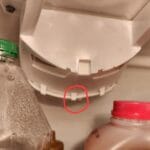If your Hisense fridge is not cooling, check if the condenser coils are dirty, as this can lead to decreased cooling. Additionally, make sure the unit is plugged in and the door is closed tightly.

Damaged seals can also affect cooling performance.
Common Causes Of A Hisense Fridge Not Cooling
If your Hisense fridge is not cooling, there are a few common causes to consider. Check if the condenser coils are dirty, the fridge door is closing tightly, or if the seals are damaged. Additionally, ensure that the fridge is plugged in and receiving power.
When your Hisense fridge is not cooling properly, it can be frustrating and concerning. However, there are several common causes that could be contributing to this issue. Understanding these causes can help you troubleshoot the problem and potentially resolve it on your own.
Here are some of the most common causes of a Hisense fridge not cooling:
- Dirty Condenser Coils: Over time, dust and dirt can accumulate on the condenser coils of your Hisense fridge, reducing their ability to dissipate heat. This can result in poor cooling performance. Regularly cleaning the condenser coils can help improve cooling efficiency.
- Poor Ventilation: If your Hisense fridge is surrounded by other objects or placed in a small, enclosed space, it may not have sufficient ventilation. This can restrict airflow and cause the fridge to overheat, leading to inadequate cooling. Ensure that there is ample space around the fridge for proper ventilation.
- Improper Installation: It’s important to ensure that your Hisense fridge is installed correctly. If it is not properly leveled or if the door seals are not aligned properly, it can lead to temperature fluctuations and inadequate cooling. Check the installation instructions and make any necessary adjustments.
- Faulty or Dirty Gasket Seals: The gasket seals on the doors of your Hisense fridge play a crucial role in maintaining the internal temperature. If these seals are dirty or damaged, they may not create an airtight seal, allowing cold air to escape. Clean the gasket seals regularly and replace any damaged seals.
- Unorganized Food Storage: Poorly organized food storage can obstruct airflow within the fridge and prevent proper cooling. Make sure there is enough space between food items and avoid overpacking the fridge. Proper organization allows for better circulation of cold air.
- Appliance Location: The location of your Hisense fridge can also affect its cooling performance. Placing it near a heat source, such as a stove or direct sunlight, can cause it to work harder and struggle to maintain the desired temperature. Keep the fridge away from sources of heat for optimal cooling.
- Malfunctioning Internal Parts: Internal parts such as the thermostat, evaporator fan, or compressor can malfunction and cause cooling issues in your Hisense fridge. If you have checked all other possible causes and the problem persists, it may be necessary to consult a professional technician to diagnose and repair the faulty parts.
By understanding these common causes of a Hisense fridge not cooling, you can take appropriate steps to troubleshoot and resolve the issue. Regular maintenance, proper ventilation, and organized food storage can go a long way in ensuring optimal cooling performance for your fridge.
If all else fails, don’t hesitate to seek professional assistance to get your Hisense fridge back to its cooling best.
How To Check And Clean The Condenser Coils
To check and clean the condenser coils on a Hisense fridge that is not cooling, make sure the fridge is unplugged and the door shuts tightly. Locate the condenser coils at the back or underneath the fridge, and carefully remove any dust or debris using a vacuum or brush.
This can improve the cooling efficiency of the fridge.
Locate the condenser coils at the back of the fridge.
- The condenser coils are an essential component of your Hisense fridge, responsible for dissipating heat and helping to maintain optimal cooling performance.
- To locate the condenser coils, simply move your fridge away from the wall to access the back panel.
- Look for a grille or cover on the back of the fridge, which is where the condenser coils are typically located.
Check for dust and debris buildup.
- Over time, the condenser coils can accumulate dust, lint, and other debris, which can impede their ability to cool effectively.
- Inspect the condenser coils for any visible buildup of dust and debris. This can often be seen as a layer of dirt covering the coils.
- Dust and debris can restrict airflow and prevent proper heat dissipation, resulting in poor cooling performance.
Use a soft brush or vacuum cleaner to gently remove the dirt.
- Once you have located the condenser coils and identified any dust or debris buildup, it’s time to clean them.
- Start by using a soft brush or a vacuum cleaner with a brush attachment to gently remove the dirt from the coils.
- Be careful not to apply too much pressure or damage the fragile coils. A gentle brushing or vacuuming motion should be sufficient.
Ensure that the coils are completely clean for optimal cooling performance.
- After removing the initial layer of dirt, take a closer look at the condenser coils to ensure they are completely clean.
- If you still see traces of dust or debris, continue brushing or vacuuming until the coils are free from any buildup.
- It’s crucial to clean the condenser coils thoroughly to ensure optimal cooling performance and energy efficiency.
Remember to regularly check and clean the condenser coils of your Hisense fridge to maintain its cooling efficiency. By keeping the coils clean, you can avoid potential issues with cooling performance and potentially save on energy costs.
Improving Ventilation For Better Cooling Efficiency
To improve ventilation and achieve better cooling efficiency in a Hisense fridge that is not cooling, make sure the condenser coils are clean and free of debris. Additionally, check that the fridge door is shut tightly and the seals are not damaged.
One of the main reasons why your Hisense fridge may not be cooling properly is inadequate ventilation. When there is not enough space for proper airflow around the fridge, it can lead to inefficient cooling. Here are some steps you can take to improve ventilation and enhance the cooling efficiency of your fridge:
- Ensure that there is enough space around the fridge for proper airflow:
- Make sure there is at least a few inches of space on all sides and at the back of the fridge.
- Avoid placing the fridge too close to walls or other appliances.
- Provide sufficient clearance above the fridge as well.
- Avoid blocking the ventilation vents with items or furniture:
- Check the location of the ventilation vents on your Hisense fridge.
- Make sure there are no items, furniture, or other obstructions blocking the vents.
- Blocked vents can restrict the airflow and cause poor cooling performance.
- Clean the ventilation vents regularly to prevent dust accumulation:
- Dust and debris can accumulate on the ventilation vents over time.
- Use a soft brush or vacuum cleaner to remove the dust from the vents.
- Regular cleaning helps maintain proper airflow and prevents cooling issues.
Improving the ventilation of your Hisense fridge is crucial for ensuring efficient cooling. By following these simple steps, you can enhance the airflow and optimize the cooling efficiency of your fridge.
Proper Installation Tips For Hisense Fridges
Proper installation is crucial to ensuring that your Hisense fridge cools effectively. Check if the condenser coils are clean and free of debris, as dirty coils can decrease cooling performance. Additionally, make sure the fridge is plugged in correctly and that the door shuts tightly to maintain the proper temperature.
When it comes to ensuring that your Hisense fridge is functioning properly and cooling efficiently, proper installation is key. Here are some important tips to follow:
- Check if the fridge is leveled to ensure proper functioning. Having a leveled fridge is crucial for optimal performance. Uneven surfaces can interfere with the cooling process, so make sure to use a leveling tool to ensure that your fridge is balanced.
- Verify that the fridge is not placed near heat sources like direct sunlight or ovens. Heat sources can make it difficult for the fridge to cool down properly. Keep your Hisense fridge away from direct sunlight, ovens, or any other appliances that emit heat.
- Allow adequate space for the refrigerator door to open fully without obstruction. It’s important to ensure that there is enough space for the refrigerator door to open fully without any obstructions. This allows the cool air to circulate freely and ensures proper cooling. Clear away any clutter or objects that may block the door from opening completely.
- Keep the refrigerator coils clean. Dirty condenser coils can affect the cooling efficiency of your Hisense fridge. Regularly check and clean the coils to prevent dust and debris from accumulating. This can be done using a soft brush or vacuum cleaner.
- Ensure proper ventilation: Proper ventilation is essential for the fridge to cool effectively. Make sure that the back of the fridge is not against a wall or any other surface that restricts airflow. Allow at least a few inches of space between the fridge and the wall.
- Avoid overloading the fridge. Overloading the fridge can obstruct airflow and make it harder for the unit to cool properly. Organize the items in your fridge to ensure proper air circulation. Don’t overcrowd or stuff the shelves.
- Check the gasket seals. Faulty or dirty gasket seals can let cool air escape and warm air enter the fridge, affecting its cooling efficiency. Regularly inspect the gasket seals and ensure they are clean, intact, and properly sealed.
- Keep the fridge clean: Regularly clean the interior of your Hisense fridge to prevent any buildup of dirt or food particles that can affect cooling. Wipe spills immediately and sanitize the shelves and drawers to maintain a hygienic environment.
- Avoid frequent opening of the door: Opening the fridge door frequently can cause cool air to escape and warm air to enter, resulting in improper cooling. Be mindful of how often you open the door and retrieve items from the fridge.
- Follow the manufacturer’s instructions. Lastly, always refer to the manufacturer’s instructions for specific installation recommendations for your Hisense fridge model. They provide valuable information to ensure the proper functioning and longevity of your appliance.
By following these proper installation tips, you can optimize the cooling performance of your Hisense fridge and ensure that your food remains fresh and cool.
Checking And Maintaining Gasket Seals
To check and maintain gasket seals on a Hisense fridge that is not cooling, make sure the condenser coils are clean and free of debris. Additionally, ensure the fridge door is closing tightly and that the seals are not damaged. These steps can help improve cooling efficiency and resolve the issue.
Inspect the gasket seals for any signs of wear or damage.
- Check the gasket seals around the edge of the fridge door for any visible signs of wear, cracks, or tears.
- Run your fingers along the seals to feel for any areas that may be loose or not properly sealed.
- Look for any gaps or spaces between the seals and the fridge door that could let cold air escape.
Clean the gasket seals with mild detergent and warm water.
- Mix a mild detergent with warm water in a bowl or bucket.
- Dip a clean cloth or sponge into the soapy water and wring out any excess liquid.
- Wipe the gasket seals with a damp cloth, making sure to clean both the inner and outer edges.
- Pay special attention to any areas that may be sticky or have built-up dirt or grime.
- Rinse the cloth or sponge in clean water and repeat the process to remove any soap residue.
Ensure that the gasket seals are properly aligned and tightly sealed to maintain cooling efficiency.
- Close the fridge door and inspect the gasket seals to ensure they align evenly with the fridge body.
- Press along the entire length of the seals using your fingers to check for a snug and tight fit against the fridge.
- If you notice any areas that are loose or not sealing properly, adjust the seals by gently pulling them toward the fridge body.
- Make sure the seals are aligned correctly, and try closing the door again to check for a tight seal.
- A properly sealed gasket is essential for maintaining the cooling efficiency of your Hisense fridge.
Organizing Food Storage For Optimal Cooling
If your Hisense fridge is not cooling, there could be several reasons for it. Check if the condenser coils are dirty, ensure that the fridge is plugged in properly, and make sure that the door is closing tightly. Proper organization of food storage can also help optimize cooling.
When it comes to maximizing the cooling efficiency of your Hisense fridge, proper organization is key. By following these tips, you can ensure that your food stays fresh and cool:
- Avoid overloading the fridge with food items. It is essential not to overcrowd the fridge with too many food items. Overloading the shelves can restrict airflow and prevent the proper circulation of cold air. This can lead to uneven cooling and potential spoilage.
- Leave enough space between items for proper airflow. To allow for optimal cooling, make sure to leave enough space between items on the shelves. This allows for better circulation of cold air and ensures that each item receives the cooling it needs to stay fresh.
- Keep perishable items away from the fridge walls to maximize cooling. Perishable items, such as dairy products and meats, should be kept away from the walls of the fridge. The walls tend to be colder, and placing perishable items there can result in freezing or uneven cooling. By keeping these items in the central part of the fridge, you can ensure they receive consistent and optimal cooling.
Properly organizing your food storage in the Hisense fridge can go a long way in maintaining its cooling efficiency. By avoiding overloading, leaving space for airflow, and keeping perishable items away from the walls, you can ensure that your food stays cool and fresh for longer.
Troubleshooting Malfunctioning Internal Parts
If you’re dealing with a Hisense fridge not cooling, it could be due to malfunctioning internal parts. Check for issues such as dirty condenser coils, poor ventilation, faulty gasket seals, or incorrect installation.
If you’re experiencing issues with your Hisense fridge not cooling properly, it could be due to malfunctioning internal parts. Here are some troubleshooting steps to help you identify and fix the problem:
Check for any error codes or indicators on the fridge’s display panel.
- Take a look at the display panel of your Hisense fridge to see if any error codes or indicators are present.
- Error codes or indicators can provide valuable information about the specific issue your fridge is experiencing.
- Refer to the user manual for a list of error codes and their corresponding troubleshooting steps.
Consult the user manual or contact Hisense Customer Support for specific troubleshooting steps:
- If you’re unsure about how to troubleshoot the issue or if the error codes on the display panel are unclear, refer to the user manual.
- The user manual should provide specific troubleshooting steps for various issues, including problems with internal parts.
- If you can’t find a solution in the user manual, consider reaching out to Hisense customer support for further assistance. They can provide you with personalized troubleshooting steps.
Schedule a professional repair service to fix any internal part issues:
- If you’ve exhausted all troubleshooting options and your Hisense fridge still isn’t cooling properly, it may be necessary to schedule a professional repair service.
- Internal part issues can be complex and require specialized knowledge and tools to fix.
- Contact a reputable repair service that is familiar with Hisense fridges to ensure a proper diagnosis and repair of any malfunctioning internal parts.
Remember to always follow safety guidelines and ensure that your fridge is disconnected from the power source before attempting any troubleshooting or repairs.
By following these troubleshooting steps, you can address any malfunctioning internal parts in your Hisense fridge and get it back to optimal cooling performance.
Frequently Asked Questions
How do I reset my Hisense refrigerator?
To reset your Hisense refrigerator, switch it off from the power switch and wait for five minutes before turning it back on. It may take up to four hours for the unit to reach the optimal temperature.
Why is my refrigerator working but not cooling?
There could be several reasons why your refrigerator is not cooling, even though it is working. Some common causes include dirty condenser coils, poor ventilation, improper installation, faulty or dirty gasket seals, unorganized food storage, appliance location, and malfunctioning internal parts.
Check if the condenser coils are dirty, as they need to be clean to cool the fridge effectively.
How Do You Reset a Refrigerator That Is Not Cooling?
To reset a refrigerator that is not cooling, switch it off from the power switch and wait for five minutes before turning it back on. It may take up to four hours for the refrigerator to reach an optimal temperature.
Ensure that the condenser coils are clean and free of dust and debris to ensure proper cooling.
Why is my Hisense fridge not cooling properly?
If your Hisense fridge is not cooling properly, it could be due to various factors such as a dirty condenser coil, poor ventilation, faulty seals, or even incorrect food storage.
How Do I Fix a Hisense Fridge That Is Not Cooling?
To fix a Hisense fridge that is not cooling, you can start by checking if the condenser coils are dirty and cleaning them if necessary. You should also ensure proper ventilation, check the seals for any damage, and organize your food storage to allow proper airflow.
Conclusion
If you’re experiencing a Hisense fridge not cooling, there are several potential causes and solutions to consider. One common issue is dirty condenser coils, which can prevent proper heat dissipation and lead to decreased cooling. Make sure to check and clean the condenser coils regularly to ensure they are free of dust and debris.
Another potential cause could be poor ventilation or improper installation, so it’s important to ensure that the fridge is properly positioned and has adequate airflow. Faulty or dirty gasket seals can also contribute to cooling problems, so inspect and clean the gaskets regularly.
Additionally, unorganized food storage and malfunctioning internal parts can also affect cooling performance. Remember to reset the unit by switching it off and waiting five minutes before turning it back on. Finally, if none of these solutions work, it may be necessary to seek professional assistance. Keep these tips in mind to troubleshoot and resolve the issue with your Hisense fridge not cooling.




